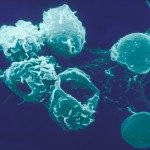Lien vers Pubmed [PMID] – 10725712
J. Immunol. 2000 Apr;164(7):3573-80
The mechanisms leading to stable T cell numbers in the periphery of a healthy animal are, to date, not well understood. We followed the expansion of CD45RBhigh (naive) and CD45RBlow (activated/memory) CD4 T cells transferred from normal mice into syngeneic Rag-20/0 recipients and the dynamics of peripheral reconstitution when both populations were coinjected. Naive cells acquired an activated phenotype and showed a high proliferative capacity that was dependent on the environment in which the recipients were kept (specific pathogen-free vs conventional housing conditions), the age of the recipients, and the presence of CD45RBlow T cells in the injected cohort. CD45RBlow CD4 T cells protected the host from CD45RBhigh CD4 T cell-induced inflammatory bowel disease and showed a limited degree of expansion. CD45RBlow CD4 T cells isolated from GF mice also showed the ability to prevent inflammatory bowel disease, indicating that at least part of the natural regulatory T cells are self-reactive. The results indicate that 1) peripheral T cell expansion in lymphocyte-deficient recipients represent classical immune responses, which are mainly promoted by exogenous Ags and 2) natural regulatory T cells control the size of the activated/memory peripheral CD4 T cell compartment.



